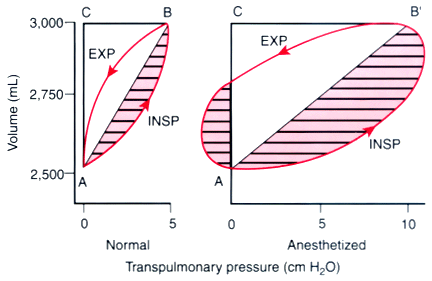 |
 |
Figure 17-13
Lung volume plotted against transpulmonary pressure in
a pressure-volume diagram for an healthy awake (normal) and an anesthetized patient.
The lung compliance of the awake patient (slope of line AB = 100 mL/cm H2
O)
equals that shown for the small dependent alveoli in Figure
17-3
. The lung compliance of the anesthetized patient (slope of line AB'
= 50 mL/cm H2
O) equals that shown for the medium midlung alveoli in Figure
17-3
and for the anesthetized patient in Figure
17-12
. The total area within the oval
and triangles has the dimensions of pressure multiplied
by volume and represents the total work of breathing. The hatched
area to the right of lines AB and AB' represents the active inspiratory
work necessary to overcome resistance to airflow during inspiration (INSP). The
hatched area to the left of the triangle AB'C represents
the active expiratory work necessary to overcome resistance to airflow during expiration
(EXP). Expiration is passive in the healthy subject because sufficient potential
energy is stored during inspiration to produce expiratory airflow. The fraction
of total inspiratory work necessary to overcome elastic resistance is shown by the
triangles ABC and AB'C. The anesthetized patient has decreased compliance and increased
elastic resistance work (triangle AB'C) when compared with the healthy patient's
compliance and elastic resistance work (triangle ABC). The anesthetized patient
shown in this figure has increased airway resistance to both inspiratory and expiratory
work.

 |
